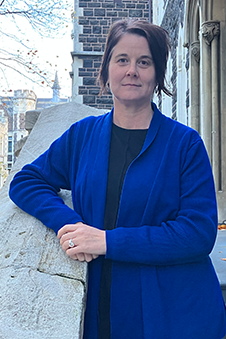
Clarity on the role of agencies managing child welfare cases will help in identifying the who and when of supporting at-risk tamariki and their whānau.
Community organisations making child welfare reports to Oranga Tamariki say it’s not uncommon to be met with delayed decisions or silence, even on high-risk cases, a new Otago study has found.
The research, published in Child and Youth Services Review, and funded by the Royal Society of New Zealand Marsden fund, examined why and how reports are made by non-governmental organisations (NGOs) to the statutory child protection agency Oranga Tamariki.

Associate Professor Emily Keddell
Lead author Associate Professor Emily Keddell, from the Social and Community Work programme, says a key finding was a disconnect between the expectation of NGOS and Oranga Tamariki over which organisation should respond in child welfare cases.
There was a growing sense that NGO reports of even high-risk cases to Oranga Tamariki are not responded to, leaving community organisations with nowhere else to turn.
“This leaves children at risk and creates anxieties and ethical ‘trade offs’ for community professionals, who must balance their relationship with whānau and its use in risk mitigation, against the likely response.”
Associate Professor Keddell says a lack of workforce capacity within Oranga Tamariki as it struggles to fill posts, as well as reducing funding to the NGO sector, has led to a growing gap between the two, challenging their ability to provide a seamless public health response to child abuse and neglect.
“This results in a growing number of families whose needs and risks are considered by NGO workers to be too complex for their service, but who do not meet the threshold for Oranga Tamariki to work with.”
Researchers interviewed community support workers from two large NGOs – one each from the North and South Islands – that have more than 70 years combined experience and hold contracts with Oranga Tamariki.
The study found community professionals are working closely with whānau in accordance with New Zealand’s child protection reforms in recent years, which has seen NGOs take a bigger role in early support and services offered to whānau, and Oranga Tamariki move away from unnecessary intervention.
Some of the major changes since reforms were introduced include suspected drug use being perceived as less harmful to children than in earlier times, and non-severe isolated incidents of a parent striking a child being viewed as the remit of community professionals to respond to.
NGO workers support this direction, accepting they have a greater role to play in offering early support, addressing possible risks of harm, and help with parenting.
They say they only escalate cases to Oranga Tamariki for statutory intervention after all their efforts to support whānau have been exhausted. The decision to report is made after a careful evaluation of the complex mix of protective and risk factors, and the nature of the relationships that community professionals have with families.
Community workers interviewed in the study say they are frustrated at incidents when they have tried to report ‘last resort’ cases and Oranga Tamariki has not acted, leading to concerns that at-risk children would ‘slip through the cracks’.
They spoke of various response experiences, from ‘waiting hours’ on the phone to speak to a social worker, receiving automatic email responses but nothing else, or waiting weeks to hear if Oranga Tamariki had formally intervened and having to follow up with multiple emails and calls.
Throughout this time, children who had disclosed risky situations to community workers were anxiously waiting to hear if Oranga Tamariki was going to intervene, knowing their parents might be angry at their disclosure.
Workers say they feel like Oranga Tamariki’s threshold for reporting cases has increased to ‘very high’ in recent years, but the threshold itself has not been clarified.
The lack of consensus between NGOs and Oranga Tamariki on what kinds of cases merit intervention, not only results in a lack of follow up, but also can influence whether NGOs report similar cases in the future, the research found.
Associate Professor Keddell says where previous reports are not acted on, or there has been no feedback about them, community professionals lose faith in reporting as a mechanism to keep children safe, and opportunities for collaborative practice are lost.
“These findings point to the need for a clearer consensus between all parties of what kinds of cases should be reported to Oranga Tamariki, clearer role definition between agencies, and the need for increased resources and investment in community agencies and schools to be able to undertake their intensifying role.
“Oranga Tamariki also needs greater workforce capacity at their front-door to be able to make well-informed decisions and communicate these clearly to reporters and whānau.
“Where policy aims to reduce the involvement of statutory child protection agencies and reduce care entry, greater provision of intensive whānau services and resources are needed in the community.”
Publication details:
Authors: Emily Keddell, Sarah Colhoun, Pauline Norris, Esther Willing
Child and Youth Services Review